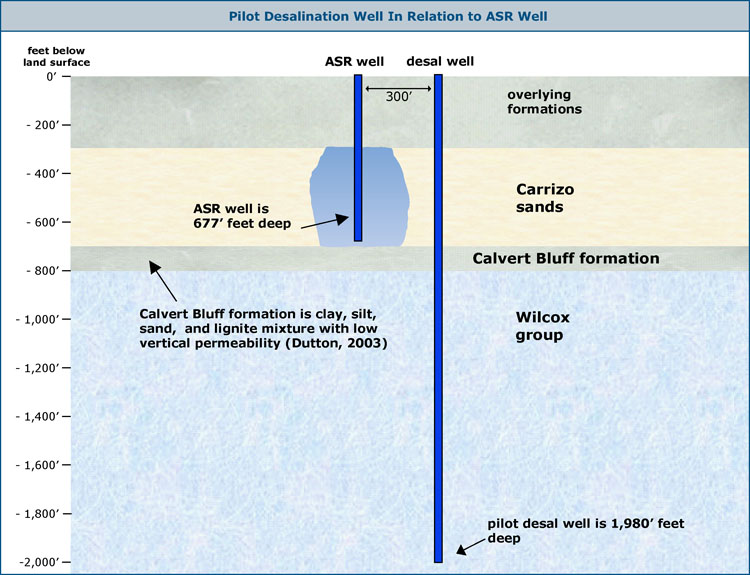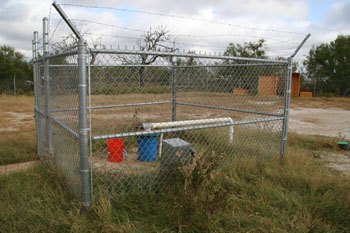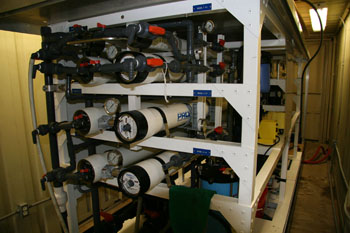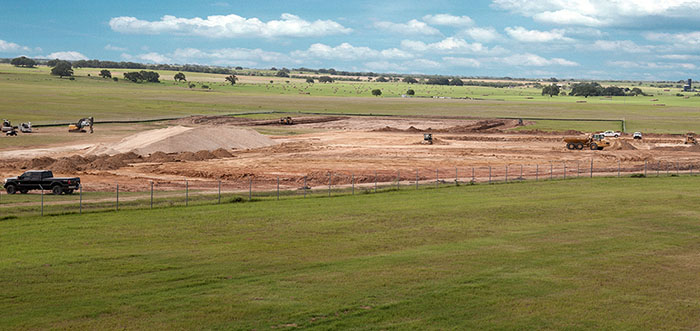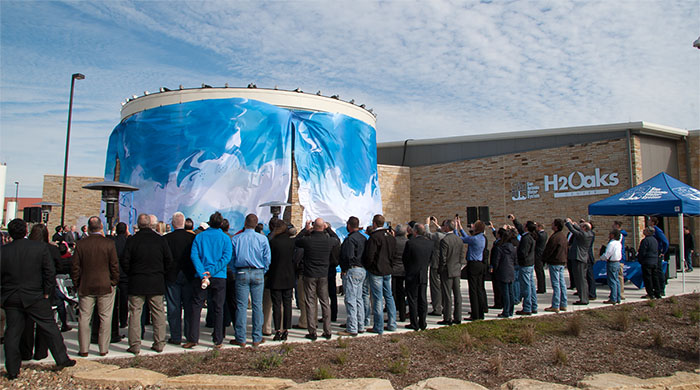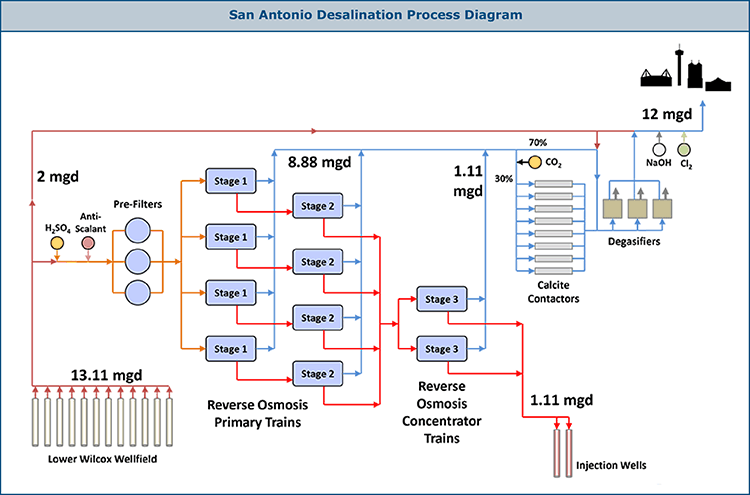
|
|
Desalination Desalination involves removing the salt from water to make it drinkable. There are several ways to do it, and it is not a new idea at all. Sailors have been using solar evaporation to separate salt from sea water for at least several thousand years. Most of the world’s 1,500 or so desalination plants use distillation as the process, and there are also flash evaporation and electrodialysis methods. All these methods are very expensive, so historically desalination has only been used where other alternatives are also very expensive, such as desert cities. However, an exploding world demand for potable water has led to a lot of research and development in this field and a new, cheaper process has been developed that involves heating sea water and forcing it through membranes to remove the salt from the water. The process is even cheaper if the desalination plant can be located next to an electrical power plant that is already heating sea water to use for cooling the electrical generating units. Even so, it is still more expensive than other alternatives, but it is indeed becoming more competitive and could become a viable alternative to Edwards water. There is also a lot of interest in using local, brackish groundwaters as a source for desalination instead of ocean water. Such waters typically have only one-tenth the salinity of sea water, so desalination can be accomplished more easily and transportation is less of an issue.
In April 2000 the Texas Water Development Board approved a $59,000 grant to the Lavaca-Navadid River Authority to determine if building a $400 million plant on Matagorda Bay at Point Comfort would be economically and environmentally feasible. There is a power plant at this location that could supply the heated sea water for the membrane process. The study was released two months later and the cost rose to $755 million, but this included the cost of transmission facilities to San Antonio. The study estimated that a 50-50 mix of desalinated water and water treated by other conventional methods could be delivered to San Antonio users for about $2.80 per thousand gallons, compared to a current cost of $1.36 per thousand gallons. A similar plant being constructed in Tampa, Florida will raise customer’s water bills by about $7.50 a month (1), (2). A major advantage of desalination of ocean water is that water is always available even in the most severe droughts. The main environmental concerns of this project are increased salinity levels in Matagorda Bay and the fate of plankton and tiny sea creatures in the water removed for the process. Supporters say it won’t raise the salinity level appreciably and that organisms can be vacuumed out and replaced into the ocean. No one knows yet how this project would be funded. It’s possible San Antonio could choose to construct its own transmission facilities and also use the pipelines to bring water to San Antonio from other sources (3), (4). On April 29 2002 Texas Governor Rick Perry visited San Antonio and announced his intention to push for construction of a 25 mgd desalination plant on the Texas coast. He said "Though it may be many years, if not decades, before ocean water is a prime source of water for Texas to use, we must begin the groundwork today so that future Texans have an abundant, drought-proof supply of water." (5). In November 2002 the South Central Texas Regional Water Planning Group endorsed a proposal by the San Antonio Water System, the San Antonio River Authority, and the San Patricio Municipal Water District to build and operate a desalination plant that could produce eight million gallons per day by 2006. The project would include a plant to purify brackish groundwater in San Patricio county and another plant to purify ocean water. Initially it would not deliver water to San Antonio but would free up surface water in the Nueces River Basin now used by the city of Corpus Christi, thereby reducing pressure on the Edwards to meet those needs. Corpus Christi has it's own competing proposal to build it's own desalination plant and then sell surface water rights to San Antonio. SAWS indicated it is not interested in a customer relationship with Corpus (6). In April of 2004, the city of Brownsville dedicated its new Southmost Regional desalination plant, which is designed to turn brackish groundwater from the Gulf Coast Aquifer into drinking water. The plant cost $21.1 million and has a capacity of 7.5 million gallons per day. It is the city's first drought-proof source of water. By 2004, there were more than 100 desalination plants in Texas, all of them treating either brackish groundwater or surface water. Some of the larger facilities are in Sherman (26.4 mgd), Lake Granbury (14.2 mgd), and Fort Stockton (12.7 mgd). El Paso Water Utilities is planning a 29 mgd facility, and the San Antonio Water System is also studying the feasibility of withdrawing and treating saline water from the Edwards Aquifer (7). In August of 2004, Governor Rick Perry gave the concept of desalination another shot in the arm by delivering a speech in which he claimed that membrane technologies "will change the world forever". He suggested that Texas should lead the nation by building the country's first large-scale desalination plant (8). In April of 2006 the city of Brownsville began construction on a pilot-scale ocean water desalination plant that will produce about 100,000 gallons per day. The main purpose of the facility will be to determine how to develop a full-scale plant and what financial incentives will be needed (9). Also in 2006, the San Antonio Water System began tests at several sites to evaluate the feasibility of constructing a plant to desalinate brackish water from the Wilcox Aquifer. One site in Atascosa county seemed especially promising, and SAWS set a goal to have an operating facility by early 2011 that could produce up to 25 million gallons per day (10). In August of 2007, the city of El Paso opened the Kay Bailey Hutchison Desalination Plant, which will eventually supply 27.5 million gallons of drinking water daily. Officials said it is the largest desal plant outside of a coastal area. Constructed at a cost of $87 million, it draws brackish groundwater from underneath Fort Bliss. Costs were expected to be about $1.65 per thousand gallons (11). In October of 2007, under intense local pressure from area residents, the board of the Evergreen Underground Water District voted to rescind an agreement it had made with SAWS to regulate and permit the production and export of brackish Wilcox water. Under the agreement, the district was to have issued permits to SAWS after the utility showed the water was available and production was not likely to effect freshwater supplies from the the overlying Carrizo aquifer. If an impact occurred, SAWS would have to limit or stop production. In return, SAWS agreed to abandon plans to pump fresh water (12). In January of 2008, a citizens panel endorsed the San Antonio Water System plan for desalination, but it noted that local opposition may turn out to be a bigger obstacle than any technological challenges. SAWS Board Chairman Alex Briseno said SAWS had not been proactive in doing outreach to the communities involved, but "We don't intend to just go to a place and take its water. The goal is to have a win-win situation." Some of the benefits to the local community could include providing treated water or economic development funds (13). In July of 2008 Atascosa residents were upset by news that SAWS had donated $10,000 to help sponsor their annual Cowboy Homecoming festival. Many considered it a "bribe" to quell opposition. After much public outcry at a packed City Council meeting, officials said they would not accept the money (14). In response, SAWS interim CEO Robert Puente said the contribution was misconstrued and said "I give you my word as a fellow Texan that our gestures were made in good faith and reflect our sincere attempt to respect your natural resources and be a contributing member of your community." (15). In February of 2009 SAWS unveiled a revised 50-year water supply plan, and the desalination component was scaled back to 11,800 acre-feet per year, or about 10.5 million gallons per day. Originally the project was envisioned to produce up to 25,000 acre-feet per year. The SAWS desalination wellfield will now be entirely within Bexar county on the Twin Oaks ASR site; previously, it was a multi-county design. The current goal is to have the project online by 2016 (16). SAWS began testing a pilot well on the Twin Oaks site to confirm the treatment requirements for the brackish water and to evaluate whether brackish water could be produced without affecting the stored Edwards water in the Carrizo sands. Brackish water will be produced from the Wilcox Group, which is deeper than the Carrizo sands and separated by the Calvert Bluff formation, which has very low vertical permeability, so waters in the formations above and below do not mix. All the tests produced excellent results and SAWS went ahead with design of a full-scale project at Twin Oaks. By mid-2012, drilling had begun and SAWS indicated it was on track for a 2016 startup.
In March of 2010 Weir Labatt, who has been involved in regional water issues for decades as a San Antonio city councilman and an EAA and Texas Water Development Board member, said that a large-scale desalination plant on the coast is the solution to the city’s future water needs. While participating in a panel discussion for radio broadcast, Mr. Labatt said “I think SAWS ought to crank up and put a plant on the coast.” SAWS long-term water plan does include such a plant, but not until 2060. SAWS President and CEO Robert Puente said "That’s finance science fiction today." Ocean water desalination is extraordinarily expensive – more than 10 times the cost of Aquifer water, and a plant and pipeline would cost well over $1 billion in today’s dollars (17). In April of 2012, the Guadalupe-Blanco River Authority asked consultants to state their qualifications for preparing a feasibility study for a large scale seawater desalination plant. It is envisioned such a plant would have an initial capacity of 25 million gallons per day and would take about 10 years to develop (18). It would easily cost more than $200 million. Although desalination would be a reliable and inexhaustible water source, it is not expected to become a major part of the state's water supply. According to the State Water Plan, by 2060 only about 3.4% of the state's water needs would be met through desalination; of that, 1.4% would be sourced from seawater and 2% from brackish groundwater. In April of 2013, Texas Land Commissioner Jerry Patterson announced his agency would partner with GBRA on the study, chipping in $300,000 of the approximate $2 million cost (19). By June, GBRA had selected MWH Global to conduct the study, with Dr. Les Shephard of the Texas Sustainable Energy Research Institute at UTSA serving as client project director. It was expected the study would take up to 20 months to complete (20). One of the difficulties in developing desalination projects is the uncertainty caused by Texas' patchwork approach to groundwater management. There are more than 120 groundwater districts in the state with a cornucopia of rules and competing interests. They typically issue three to five year permits that are not automatically renewed, and that timeframe is far too short for utilities or developers contemplating very large investments in long-term water projects. In January of 2013, SAWS announced it would support new legislation being worked on by State Rep. Lyle Larson for the 2013 session. The goal is to bring more certainty to the brackish and fresh water permits issued by groundwater districts (21). On February 6, 2014, word leaked that instead of accepting any of several proposals it had solicited from the private sector to provide new supplies, SAWS would recommend to its Board of Trustees an expansion of its brackish water desalination plans (22). SAWS CEO Robert Puente confirmed the rumor while speaking at a water forum later that day, and also announced SAWS had begun exploring the possibility of working in conjunction with the city's energy utility, City Public Service Energy, to co-locate a new gas-fired power plant at the brackish desalination site (23). This would have benefits for both utilities - the power plant would be used to meet peak demands and during off-peak hours, the energy could be directed towards water production and purification. In return, some of the water produced would be used to cool the power plant. As currently envisioned, the expansion could eventually add up to 50,000 acre-feet per year to city supplies, and it would be available for centuries. Not everyone was immediately sold on the idea of expanding desalination instead of accepting one of the private sector proposals offered for new supplies. Mayor Julian Castro said he was open to support desalination as a way for San Antonio to "control our own destiny", but he also wanted to keep the door open to purchase of other supplies (24). Long-time water advocate Weir Labatt also said he supported desalination but feared the city might fumble yet another chance to buy water from outside the region. "San Antonio had had a history of failed attempts to secure additional water," he said. "What I hope is this is not another chapter in that same story. I'm afraid it might be." (25) Others pointed out that shifting to expanded desalination could be seen as a shrewd adaptive response to the availability of technologies that were not economical until recently. Another benefit of a brackish desalination expansion is that it offers the potential to phase in capacity as needed in the future, so that investment could be matched to need. Proponents also pointed out that all the private sector proposals SAWS was considering were unacceptable either because of staunch public opposition or because they did not guarantee any water. By June, the business community and elected officials were successful in encouraging SAWS to pursue both desalination and other supplies (26). In July of 2014, SAWS began pushing dirt on its desalination plant:
On November 10 2016, SAWS delivered the first water to customers from the new plant. A formal opening ceremony was held on January 28, 2017 and it was attended by many water officials and dignitaries who celebrated San Antonio’s continued success in diversifying its water resources. Below, the crowd watches as the curtain falls on the plant's inauguration: The plant can produce up to 12 million gallons per day. The process is rather typical for a desalination plant, and extra treatment steps are added to make the water chemically compatible with Edwards supplies. Let’s look at the process:
Twelve wells in the Lower Wilcox formation are about 2,000’ feet deep and produce water that is slightly salty, much less salty than seawater, so it’s easier and cheaper to treat this water as compared to ocean water. Sulfuric acid is added to the raw water to begin adjusting the water pH, and an anti-scalant compound is added to keep soluble compounds in solution, so they don’t clog up pipes. Pre-filters are then used not really as filters, but as a last line of defense to keep particles from entering the reverse osmosis membranes. This is because the RO process is intended only for removing dissolved constituents and it relies on having low turbidity in the source water. Suspended particles that cause cloudiness in the water will ruin the RO membranes. Next, there are several stages of reverse osmosis treatment. The clean water, or “permeate” leaves one stage and moves to the next, while the salty water, or “concentrate” heads toward disposal wells. The RO stages are about 90% efficient overall, so for every ten gallons that enter the plant, nine gallons of clean water are produced and one gallon of very salty water. After RO treatment, the water is much too clean to drink. In its pure form, water is highly corrosive and it needs to be stabilized with minerals before being used. In this case, the objective is to make the water chemistry very close to Edwards Aquifer water, which is high in calcium. A carbon dioxide system works in concert with eight silos filled with calcite pellets to transfer calcium to the water. Next, water enters one of three degassifier towers, which remove excess carbon dioxide. Sodium hydroxide is then added to adjust the pH to match Edwards water, and chlorine is added for disinfection. The plant can also be operated in a blend mode in which some of the raw Wilcox water is mixed with the treated water. This can reduce the need for the post-treatment addition of calcium to the water. Finally, the concentrated salty water is injected deep underground in wells that are about 5,000 feet deep. This is real salty water, but much less salty than the water that’s already down there. The receiving formation is Edwards limestone, but in this area the Edwards has a salinity of about 90,000 parts per million, almost three times as salty as ocean water. Clean water sent to town can be mixed with other water produced on the site - either Edwards Aquifer water that is stored here in the Carrizo sands, or with Carrizo water that is treated in another plant on the site. There are also two distribution lines, one to the north and one to the west. So this facility has a great deal of flexibility in managing and producing water. It can do several things at once. For example, water could be produced and treated from both the Carrizo and Wilcox aquifers at the same time that Edwards water is recharged into the Carrizo sands. Because of all the innovative water management strategies that exist here in just one location, this is a very popular place to visit for engineers and water officials. The whole world has taken notice of what San Antonio has accomplished on this site. |
||||||
|
Materials used to prepare this section: (1) "Desalination plant proposal drawing interest" San Antonio
Express-News, April 6, 2000. |

